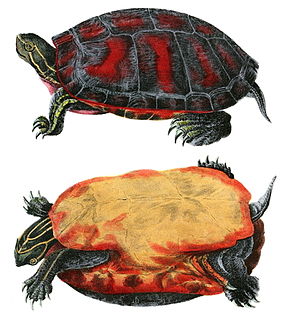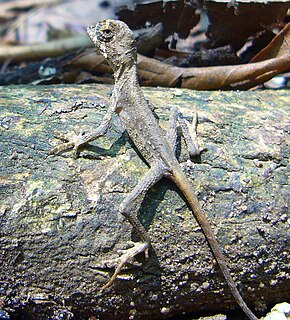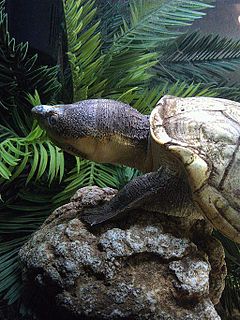 W
WCercosaura ocellata, the ocellated tegu, is a species of lizard in the family Gymnophthalmidae. It is found in Brazil, Venezuela, Guyana, Suriname, French Guiana, Peru, Bolivia, Colombia, Argentina, and Paraguay.
 W
WThe checkerboard worm lizard, Trogonophis wiegmanni, is a species of reptile in the family Trogonophidae. The species is monotypic within the genus Trogonophis, and is endemic to North Africa in Algeria, Morocco, and Tunisia. Its natural habitats are temperate forests, Mediterranean-type shrubby vegetation, temperate grassland, sandy shores, arable land, and pastureland. It is threatened by habitat loss.
 W
WCrotalus triseriatus is a venomous pit viper species found in Mexico. Two subspecies are currently recognized, including the nominate subspecies described here.
 W
WEmoia atrocostata, commonly known as the littoral whiptail-skink, mangrove skink, or littoral skink, is a species of lizard in the family Scincidae. It inhabits mangroves, back-beach vegetation and rocky shorelines. It is semi-aquatic and forages in tidal pools.
 W
WEmoia cyanura, the copper-tailed skink, is a species of skink. It is found in Borneo and South Pacific islands.
 W
WGehyra oceanica, also known as the Oceania gecko or Pacific dtella, is a species of gecko in the genus Gehyra. The larger Gehyra vorax of Fiji, Vanuatu and New Guinea has sometimes been included in this species, but is now treated as distinct.
 W
WThe gray gecko is a species of lizard in the family Sphaerodactylidae. It is endemic to Haiti.
 W
WHydromedusa is a turtle genus in the family Chelidae, commonly known as the South American snake-necked turtles. They are quite closely related to the South American side-necked swamp turtles (Acanthochelys) and the snake-necked turtles of the Australian-Melanesian region (Chelodina), but less closely to the spine-necked river turtles of South America (Podocnemididae) which belong to a more modern lineage of Pleurodira.
 W
WThe emerald tree skink, sometimes (ambiguously) known as "green tree skink" or "emerald green skink". It is a non-threatened species although it not commonly seen but it is however, becoming more and more popular in the exotic pet trade. In the Philippines, it is called Tabili in the Cebuano vernacular.
 W
WThe moth skink is a species of skink. It is found in Pacific regions including Sulawesi, Northern Papua New Guinea, Solomon Islands, Vanuatu, Tuamotu, Marquesas Islands, Pitcairn Islands, Hawaii, Indonesia, Fiji, Western Samoa, Admiralty Islands, Bismarck Archipelago, Tonga, Toga, Tegua, Cook Islands and Guam.
 W
WMicrolophus peruvianus, the Peru Pacific iguana, is a species of lava lizard endemic to the Ecuador, Peru, and Chile. The species is commonly attributed to the genus Microlophus but has been attributed to the genus Tropidurus.
 W
WEmydura macquarii, is a wide-ranging species that occurs throughout many of the rivers of the eastern half of Australia. It is found primarily in the Macquarie River basin and all its major tributaries, along with a number of coastal rivers up the New South Wales Coast. It is also found in the coastal Queensland rivers and the Cooper Creek ecosystem, along with Fraser Island.
 W
WThe northern red-bellied turtle or American red-bellied turtle is a species of turtle in the Pseudemys (cooter) genus of the family Emydidae.
 W
WThe northern river terrapin is a species of riverine turtle native to Southeast Asia. It is classified Critically Endangered by the IUCN and considered extinct in much of its former range.
 W
WThe ornate slider is turtle belonging to the genus Trachemys of the family Emydidae. It is found in Guerrero, Jalisco, Nayarit and Sinaloa in western Mexico.
 W
WOtocryptis wiegmanni, commonly called the brown-patched kangaroo lizard, Sri Lankan kangaroo lizard or Wiegmann's agama, is a small, ground-dwelling agamid lizard endemic to Sri Lanka.
 W
WSometimes called the bearded toadheads but better known by their scientific name of Phrynops this genus of turtles has often been a bit of a dumping ground for the short-necked South American turtles of the family Chelidae.
 W
WThe river cooter is a species of freshwater turtle in the family Emydidae. The species is native to the central and eastern United States.
 W
WThe rough-footed mud turtle is a species of mud turtle in the family Kinosternidae. The species is endemic to the southwestern United States and northern Mexico.
 W
WSaiphos equalis, commonly known as the yellow-bellied three-toed skink or simply three-toed skink, is a species of burrowing skink found in eastern Australia. It is the only species classified under the genus Saiphos.
 W
WThe spiny turtle is a South-East Asian turtle species. It inhabits lowland and hill rainforest, usually in the vicinity of small streams, mainly in hill areas up to 900 m above sea level.
 W
WThe wood turtle is a species of turtle endemic to North America. It is in the genus Glyptemys, a genus which contains only one other species of turtle: the bog turtle. The wood turtle reaches a straight carapace length of 14 to 20 centimeters, its defining characteristic being the pyramidal shape of the scutes on its upper shell. Morphologically, it is similar to the bog turtle, spotted turtle, and Blanding's turtle. The wood turtle exists in a broad geographic range extending from Nova Scotia in the north to Minnesota in the west and Virginia in the south. In the past, it was forced south by encroaching glaciers: skeletal remains have been found as far south as Georgia.